-
The Arisaka Type 99 - Early war vs. Late war - a comparison
In recent months I have heard a GREAT MANY oft-repeated but factually wrong myths perpetuated about the Type 99 rifle and the supposedly dangerously unsafe "last ditch" Type 99.
Let me start this little edjumacation by stating it clearly: There is no such thing as a "last ditch type 99". This misnomer was begun when American servicemen, many of whom could not read or speak Japanese, did some stupid things when occupying post-war Japan. Chief among these idiocies was the firing of service ammunition in training rifles that outwardly appeared to be Type 38 or Type 99 rifles, but were actually crudely made training rifles with unrifled barrels. These were typically not marked as imperial arms and often stated clearly on them that they were drill or training rifles (in Japanese). The predictable grenading of rifles resulted and the "last ditch 99" was born. This perception was not helped by the crude exterior appearance of real late war type 99 rifles which mirrored the cost and time saving measures implemented in Nazi Germany in the Kriegsmodell K98k .
.
Another potential source of the moniker came from the Japanese Special Naval Rifle which had a cheaply cast pot-iron receiver and generally appeared to be an unsafe rattletrap to GIs. Today we know better and the Remington 710 essentially copied the Special Naval Rifle action of WW2 in that the bolt locked directly to lugs in the barrel, the receiver serving only to hold the bolt as it was cycled. Despite a shabby apeparance, these were functionally safe rifles.
But I digress...
Even more clearly: The Imperial Japanese Army did not issue unsafe rifles. Every Type 99 from the first to the last underwent the same proof tests and was built to fire many, many rounds. The areas of production that saw compromise were in fit and finish and metal conservation on things like buttplates and monopods that had no real field value. This is MUCH easier to illustrate in photographic format.
For reference, the first Type 99 series production began at Nagoya in August, 1939.
Here is a photo of an early Type 99, a 31st series Toyo Kogyo Type 99 made in 1940 (on top) compared to a 7th Series Nagoya late war rifle made in 1944. The bayonets shown with each rifle are of the proper vintage for that rifle. Although not unsheathed, the top blade is fullered and the bottom blade is not. The top rifle would have been issued with leather accoutrements (the leather sling shown is original to this rifle) and the lower rifle would have been issued with a mix of canvas and rubberized canvas accoutrements as depicted.
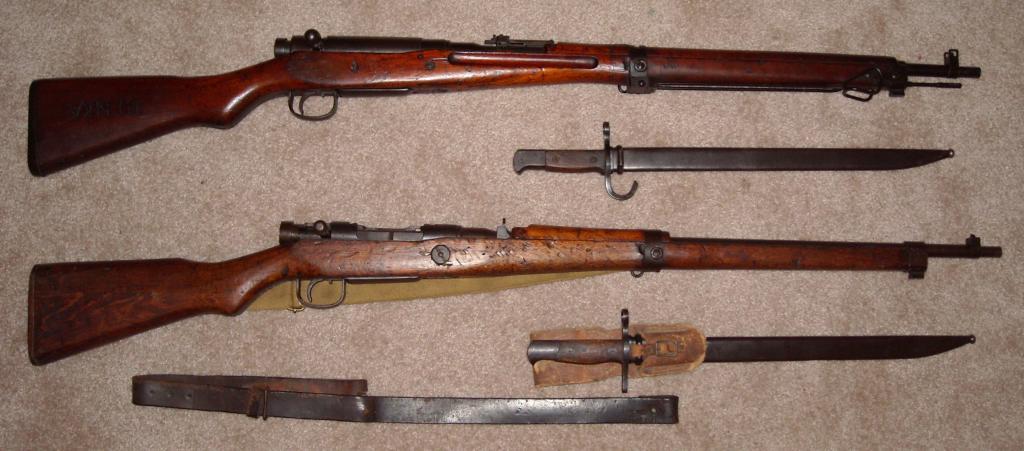
Right away there are some obvious cosmetic differences, but surprisingly few functional differences. Both rifles have the same rifling (metford pattern) and are in 7.7 Japanese, though the early rifle enjoyed the excess (for that timeframe) of a chrome-lined bore. The bolts have the same lug pattern and are functionally identical, though methods of manufacture differ. Barrel length and overall length is the same and both are battle-sivhted to 300m. and one rifle incorporated an (ineffective) stabilizing monopod for long-range shooting and anti-aircraft sights that were not oft used in combat.
Factory markings of the Toyo Kogyo:
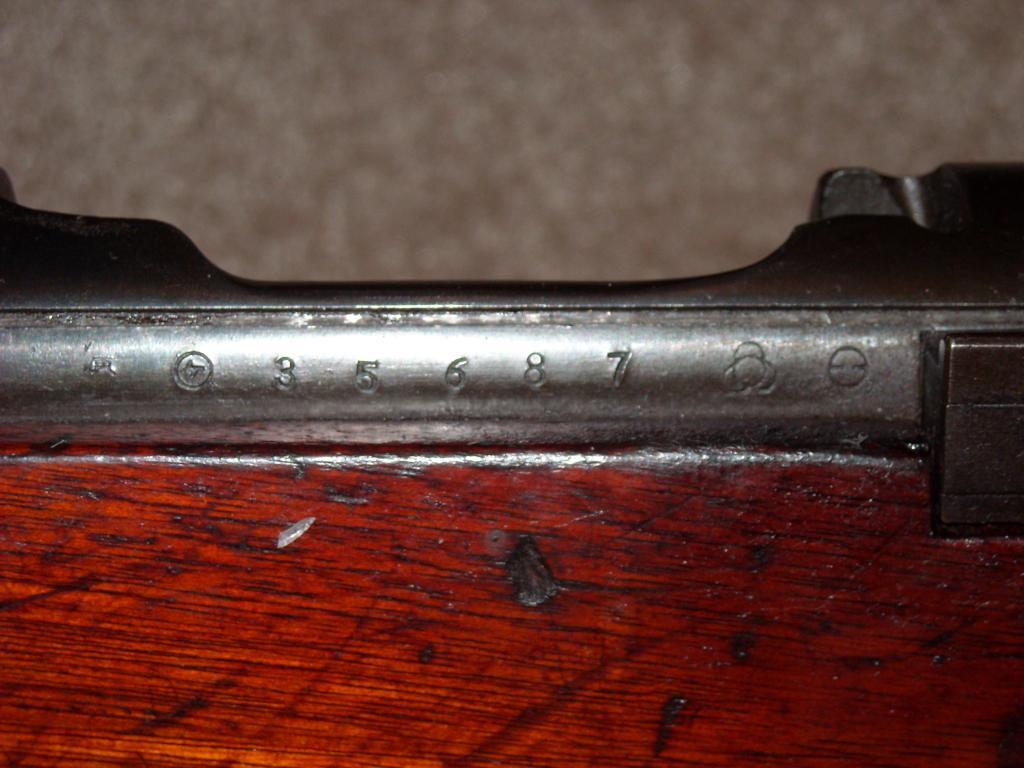
And the Nagoya:
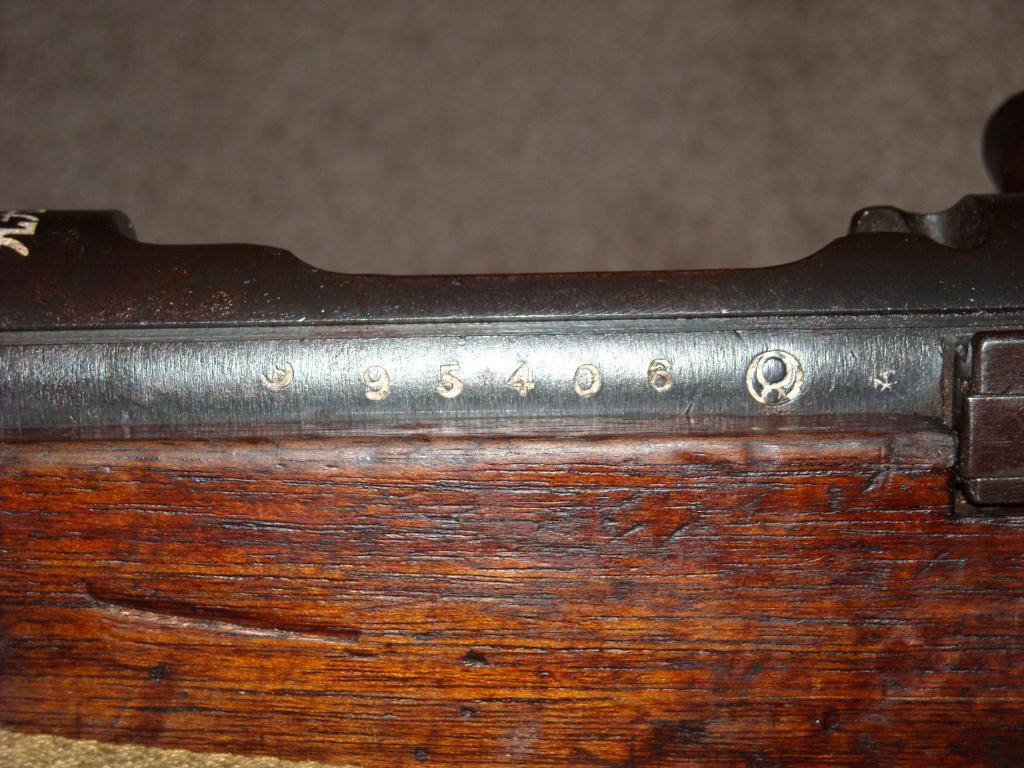
Next you'll notice the receiver markings. This is an important point - despite the crude appearance, the IJA accepted this late war rifle into the Emperor's service and it was marked and issued as a full Type 99. A few hundred rifles after this 7th series was made, Nagoya stopped stamping the receivers "Type 99". This should be regarded as another time-saving measure introduced to the "substitute standard" variants, generally characterized by fixed sights, short hand guards, and cruder external finishes. The "substitute standard" is not to be confused with "last ditch" as per my comments above. What was basically intended was that until some point point, probably around the time they dropped the Type 99 receiver script, the intent was that after Japanese victory, the rifles with shortcuts on them might later be upgraded to the early type 99 pattern with things like monopods and dust covers. The final months of the war ushered in some last changes like the omission of sling swivels, omission of the dust cover slots in the receiver, etc. This last one is odd considering dust covers had not been installed at most factories since 1941.
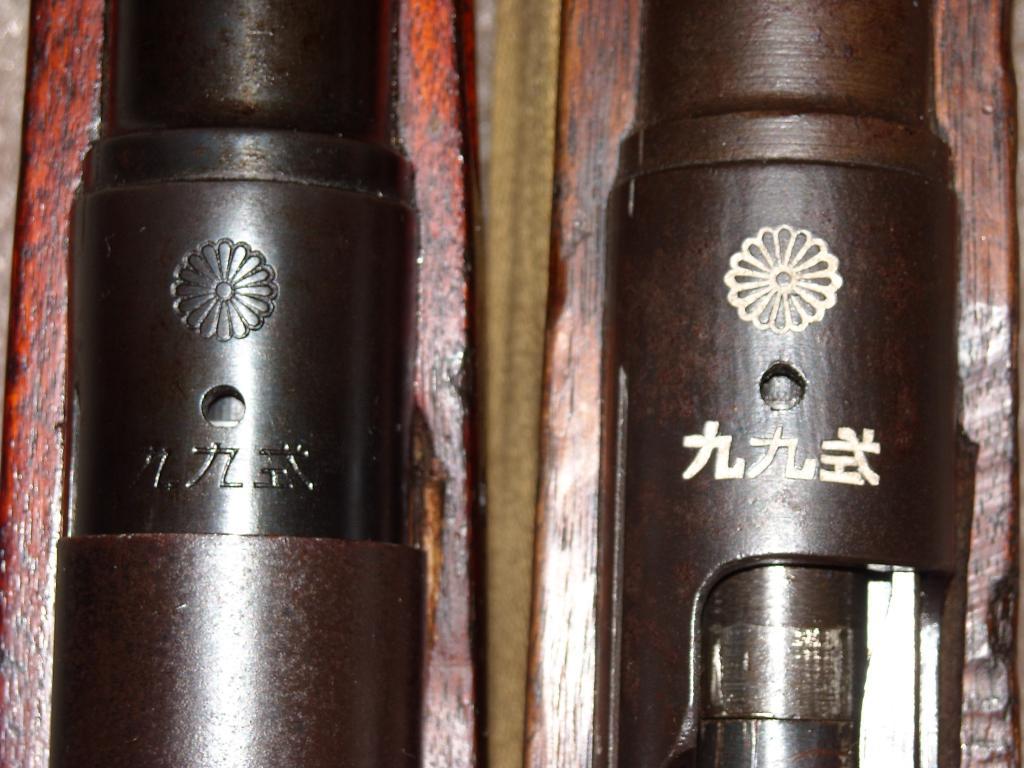
Now let's look at sights. The early Type 99 had aiming arms that could be deployed to shoot at low-flying aircraft. This might be the most useless feature ever fielded by a ww2 belligerent. Essentially unless you were shooting at a WW1 biplane, you wouldn't hit a damn thing. Also, the optimistic idea that Japanese infantrymen would direct effective fire (in volleys) out to 1500m was a nonsensical leftover from the Russo-Japanese war when area-fire machine-guns had yet to be fielded in any numbers. In practise, IJA troopers used the 300m battle sight, and in the late-war rifle, the 300m battle sight pitcure remained totally unchanged. The sighting profile of both rifles is identical.
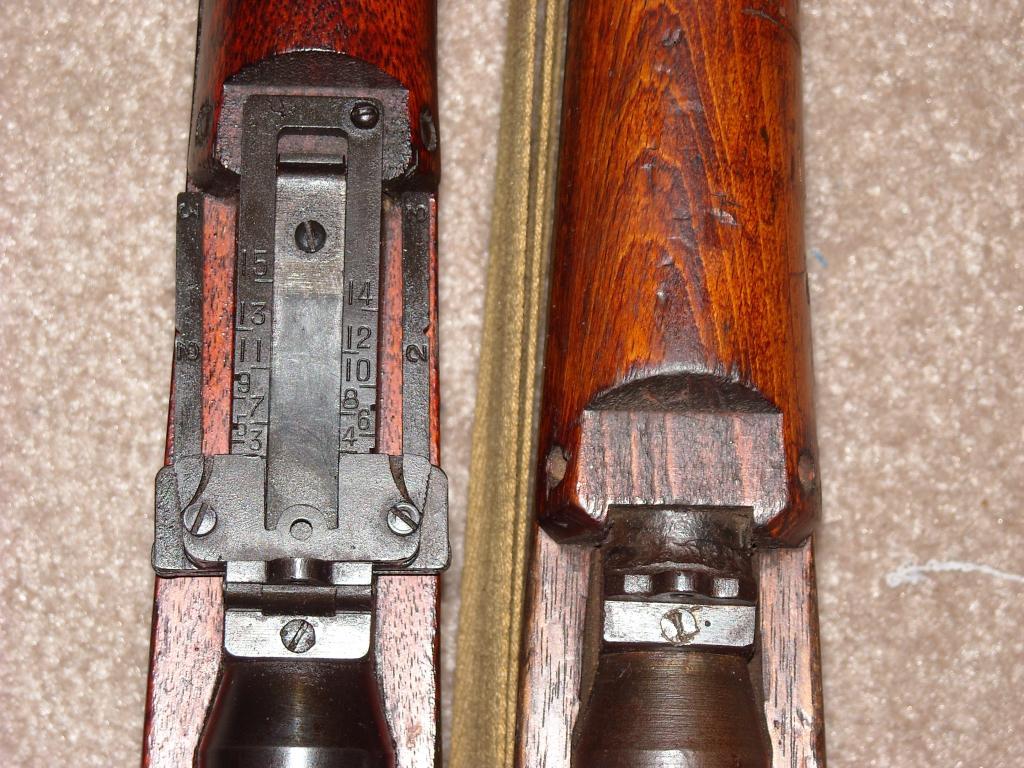
Next we move to the front sights. Both rifles use the same blade adjustable in the same manner. The original pattern front sight guards were dropped mid-war as the protection they offered was dubious to begin with and took valuable machining time to produce. Today you often see them mis-shapen on issued rifles, giving testament to their fragility. You will also note the early rifle has a finely form-stamped and machined set of barrel bands while the later rifle's bands are made of bent and welded flat stock. the latter was much cheaper to manufacture and worked just as well.
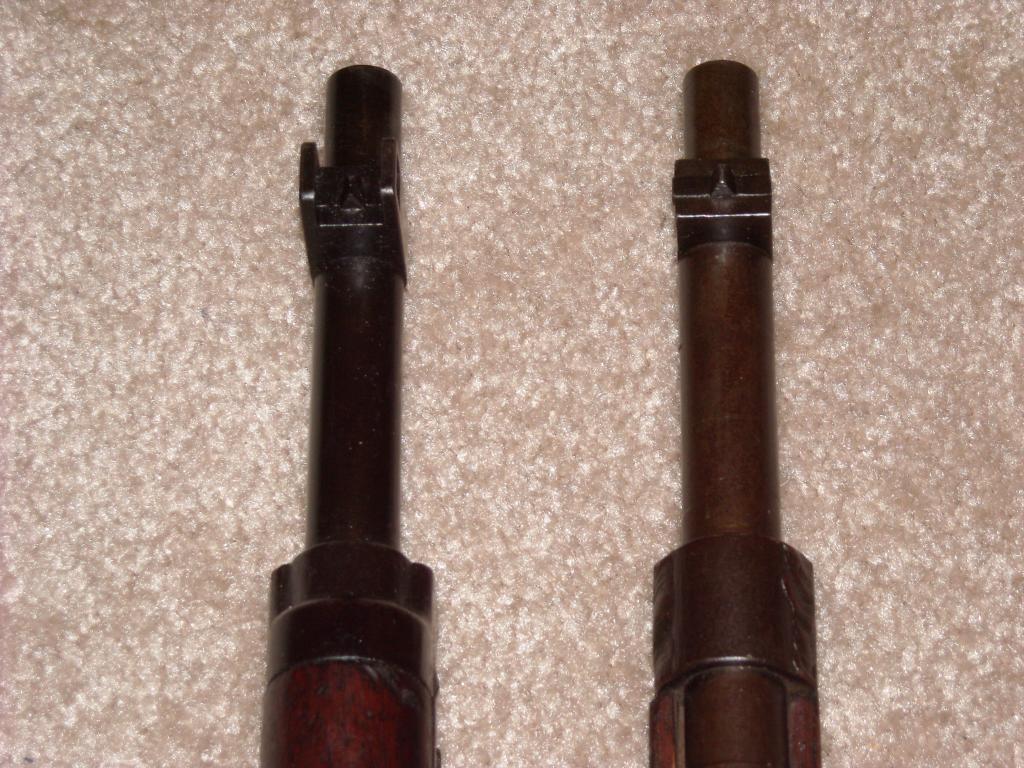
Perhaps no image will better illustrate the sacrifice of form over function as Japan's war fortunes worsened than the following photo. From the bolt root to the bolt face, both bolts are identical, though the later war bolt has less post-machining polishing on the body and the chrome lining is omitted from the bolt face. Here the similarities end. The early war bolt was forged as one piece and carefully machined to contour, all machining marks polished away and the whole assembly was mated to a sheet metal dust cover that was likely the product of Japanese observers on the Western Front in 1917. The late-war bolt was made from a cylindrical ingot to cut down on machining steps with the bolt handle left only as a short stub. A crudely cast (from low grade steel) bolt handle was then welded to the bolt body and the seam ground flush. The cocking piece was made without serration and the arc weld joining the gas shield to the shaft was left undressed to act as the "serration" to provide grip. Both bolts are indiscernibly similar in smoothness and function. If anything the late-war bolt is a little easier to operate as it is not slowed by dust cover friction and the handles are a little longer owing to the extra length needed to facilitate handle welding.
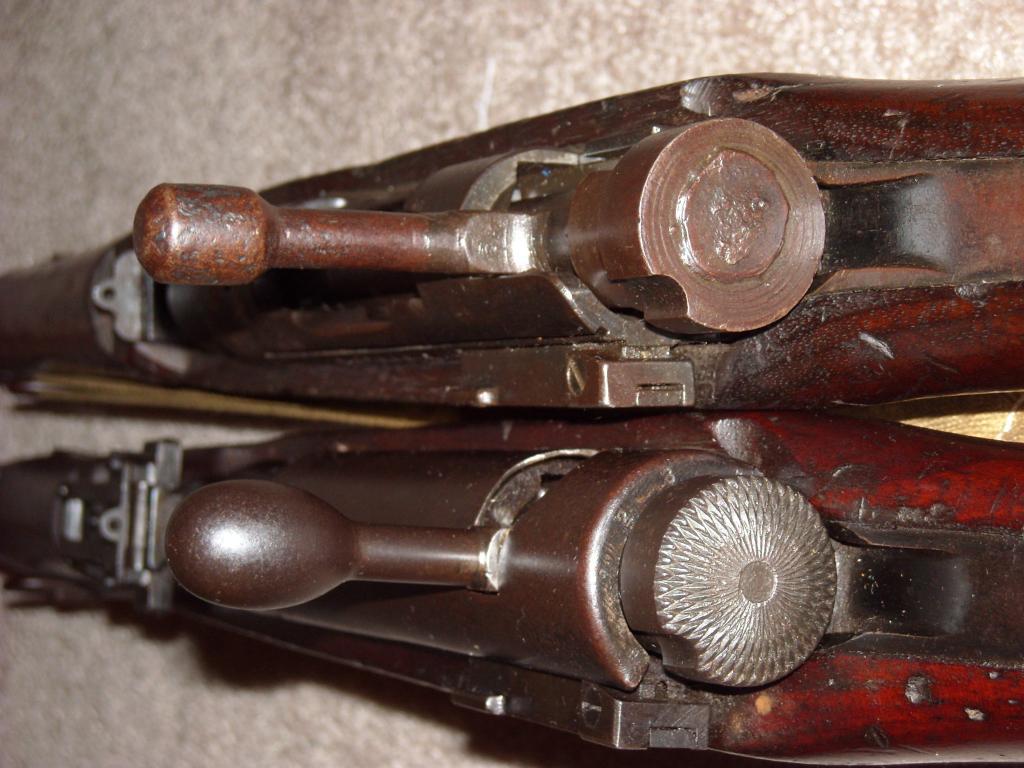
Finally, nothing screamed cheap to US servicemen like a wooden buttplate crudely nailed to the stock. This is a clear attempt by the Japanese to conserve steel after the US NAVY had ruthlessly culled the Japanese merchant fleet. The wooden plate is functional but certainly adds to the cheap appearance of the substitute 99.
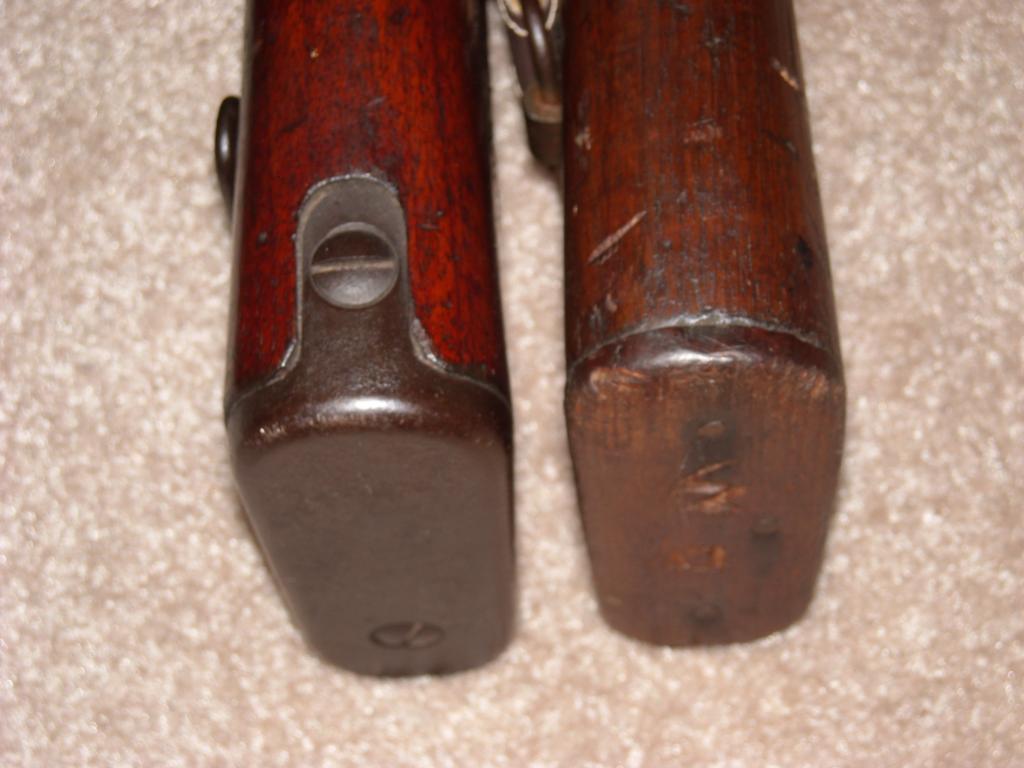
As a final word, Major General Julian S. Hatcher, in Hatcher's Notebook was clear in his defence of the Arisaka action, including the late-war action. In his opinion, backed by tests at Aberdeen Proving Grounds, the Arisaka was stronger than even a late-production M1903. Doesn't sound very "last ditch" to me.
action, including the late-war action. In his opinion, backed by tests at Aberdeen Proving Grounds, the Arisaka was stronger than even a late-production M1903. Doesn't sound very "last ditch" to me.
For clarity on this matter, Hatcher cited that the Arisaka was loaded up to 120,000 psi at which time the testing was stopped with no observed failures. All other military bolt actions tested started to have blown extractors at around 70,000 psi and started shedding locking lugs at around 90,000 psi. Some of the bolt actions tested were the 03 Springfield, 1917 Enfield, and the German 98 Mauser.
Hopefully that clears a few things up and lays some myths to rest 
Information
 |
Warning: This is a relatively older thread
This discussion is older than 360 days. Some information contained in it may no longer be current. |
|
Союз нерушимый республик свободных Сплотила навеки Великая Русь. Да здравствует созданный волей народов Единый, могучий Советский Союз!
-
The Following 26 Members Say Thank You to Claven2 For This Useful Post:
1812we1,
303Nut,
72 usmc,
728shooter,
A. F Medic,
Alkali,
ArtioZen,
aspen80,
Bill Hollinger,
burb1989,
Detroit-1,
dttuner,
Eaglelord17,
fjruple,
frankderrico,
henry r,
HOOKED ON HISTORY,
jarrodeu,
jmoore,
Midmichigun,
milano61,
oldpaul,
RCEMERalf,
Salt Flat,
WarPig1976,
WNO1958
-
01-29-2013 10:00 PM
# ADS
Friends and Sponsors

-
Legacy Member

That was great! But lets hope most guys will still believe that they are unsafe. Other wise I will not be able to get such low prices when I buy them!
-
Thank You to Detroit-1 For This Useful Post:
-
-
FREE MEMBER
NO Posting or PM's Allowed

I have one "last ditch" crude looking Type 99.
As i told people... I am looking for the roughest... crudest Type 99 I can find, to complete my collection.
I was always warned to NOT fire them, but collecting Japanese rifles, has also opened me up to Training Rifles.... which as you noted, are pretty shoddy, with no rifling in some cases.
rifles, has also opened me up to Training Rifles.... which as you noted, are pretty shoddy, with no rifling in some cases.
-
Contributing Member


I love the comparison but have to take issue with the condemnation of the aircraft sight wings. I see a lot of criticism about the Japanese rifles, the sights, the dust covers, the monopod, etc but frankly, these were very innovative additions to the rifles and far from useless. The criticism probably comes from the general prejudice against anything Japanese from WWII.
rifles, the sights, the dust covers, the monopod, etc but frankly, these were very innovative additions to the rifles and far from useless. The criticism probably comes from the general prejudice against anything Japanese from WWII.
As an officer in the US Army, I received instruction on how to shoot down aircraft with my M-16. I was also expected to provide training to those under my command in how to do so. Now if the modern US Army still has it's soldiers shooting at jet and armored helicopter aircraft with a 5.56 round, it is not a stretch to say that an impact could be made with a much heavier and more powerful Japanese round against slower and less armored aircraft. And for the record, the most common aircraft likely encountered by an infantryman was most likely going to be a liason/spotter aircraft which were as slow as the WWI biplanes and easier to shoot down. The Japanese were pretty methodical in their weapons development. I doubt they would include "useless" items on their rifles. They only removed them late in the war when they were trying to reduce materials, cost and time in production.
Just some thoughts.
-
The Following 8 Members Say Thank You to Aragorn243 For This Useful Post:
-
Senior Moderator
(Milsurp Forums)


That was a great post! Thanks for sharing the detailed photos and information. 
Bill Hollinger
"We're surrounded, that simplifies our problem!"
-
Thank You to Bill Hollinger For This Useful Post:
-
Legacy Member

I agree completely. I've had several 99's pass thru my hands, and currently have my fathers (which he brought back from the war from Okinawa) which is a late war model. It shoots like a champ. I also just finished replacing some missing parts on a late model 99 of a buddy. He thought it was an Enfield and I asked him to show it to me. There's no mistaking an Arisaka 99! That peep that replaced the flip up sight actually seems to work pretty well, and must have been great to train recruits on usage. I have to say that the looks used to keep the prices down, which is fine by me too! Nowadays though, they aren't the bargain in my neck of the woods that they used to be!
99! That peep that replaced the flip up sight actually seems to work pretty well, and must have been great to train recruits on usage. I have to say that the looks used to keep the prices down, which is fine by me too! Nowadays though, they aren't the bargain in my neck of the woods that they used to be!
-
-

Originally Posted by
Aragorn243

I love the comparison but have to take issue with the condemnation of the aircraft sight wings. I see a lot of criticism about the
Japanese
rifles, the sights, the dust covers, the monopod, etc but frankly, these were very innovative additions to the rifles and far from useless. The criticism probably comes from the general prejudice against anything Japanese from WWII.
As an officer in the US Army, I received instruction on how to shoot down aircraft with my M-16. I was also expected to provide training to those under my command in how to do so. Now if the modern US Army still has it's soldiers shooting at jet and armored helicopter aircraft with a 5.56 round, it is not a stretch to say that an impact could be made with a much heavier and more powerful Japanese round against slower and less armored aircraft. And for the record, the most common aircraft likely encountered by an infantryman was most likely going to be a liason/spotter aircraft which were as slow as the WWI biplanes and easier to shoot down. The Japanese were pretty methodical in their weapons development. I doubt they would include "useless" items on their rifles. They only removed them late in the war when they were trying to reduce materials, cost and time in production.
Just some thoughts.
Thanks for your insight! The view on the AA sight was based on my personal opinion, not any trial or fact and it's great that it's sparked some discussion  The monopod was an interesting feature as well, though in reality I believe the reason it was dropped had more to do with the height and exposure of the soldier if it were deployed - it really puts you up there and lowers cover. Since WW2, infantrymen generally want to be as low to the ground as practical. The dust cover was a good idea, but used up valuable steel better allocated elsewhere in my view. The Germans invented a similar cover in WW1, then dropped it as being to expensive for the small gain. (we're talking economies over millions of rifles here)
The monopod was an interesting feature as well, though in reality I believe the reason it was dropped had more to do with the height and exposure of the soldier if it were deployed - it really puts you up there and lowers cover. Since WW2, infantrymen generally want to be as low to the ground as practical. The dust cover was a good idea, but used up valuable steel better allocated elsewhere in my view. The Germans invented a similar cover in WW1, then dropped it as being to expensive for the small gain. (we're talking economies over millions of rifles here)
Союз нерушимый республик свободных Сплотила навеки Великая Русь. Да здравствует созданный волей народов Единый, могучий Советский Союз!
-
The Following 4 Members Say Thank You to Claven2 For This Useful Post:
-
FREE MEMBER
NO Posting or PM's Allowed

Thank you Claven2. My late father was in the US Navy during WW2 and was given a Japanese rifle as a war souvenir at the end of the war. It had been rendered inoperable by one of the machinists aboard his ship - something about the bolt being "welded". I remember him telling me that was the standing order at the time. Anyway, he gave me the rifle when I was a kid. I recall running around in the backyard with this thing playing war games with my friends. Good gawd, the thing was heavier than I was. The rifle has been sitting in my old childhood bedroom closet for the last 40 years. I take it out when I periodically visit my mom - not often enough since she's 2000 miles away. Even though it's been a few years, I still still have a clear picture in my mind & remember lots of details about it. I've often thought of having it restored to firing condition. I've always wanted to know more but never found the time to research it. But now for the first time, I know what it actually is. Turns out I have an early type 99, with mono-pod, aircraft sights, metal butt-plate, intact chrysanthemum, etc. The bayonet was lost long ago, in one of the many military moves we made to various bases around the globe, and there is no sling. But now I have a place to start. Thanks again for a great article. Walt
rifle as a war souvenir at the end of the war. It had been rendered inoperable by one of the machinists aboard his ship - something about the bolt being "welded". I remember him telling me that was the standing order at the time. Anyway, he gave me the rifle when I was a kid. I recall running around in the backyard with this thing playing war games with my friends. Good gawd, the thing was heavier than I was. The rifle has been sitting in my old childhood bedroom closet for the last 40 years. I take it out when I periodically visit my mom - not often enough since she's 2000 miles away. Even though it's been a few years, I still still have a clear picture in my mind & remember lots of details about it. I've often thought of having it restored to firing condition. I've always wanted to know more but never found the time to research it. But now for the first time, I know what it actually is. Turns out I have an early type 99, with mono-pod, aircraft sights, metal butt-plate, intact chrysanthemum, etc. The bayonet was lost long ago, in one of the many military moves we made to various bases around the globe, and there is no sling. But now I have a place to start. Thanks again for a great article. Walt
-
Senior Moderator
(Milsurp Forums)


Walt, welcome to milsurps.com. Great story and it is sure wonderful having such memories. Enjoy the site and stick around.
Bill Hollinger
"We're surrounded, that simplifies our problem!"
-
-
FREE MEMBER
NO Posting or PM's Allowed

Type 99 bolt issue
I am new to this forum and relatively new to collecting military surplus fire arms. As you seem very knowlagable in this matter I was wondering if you can help me. I recently purchased a type 99 arisaka which from what I can tell is a Toyo Kogyo mid war type 99. I was using the bolt cycling it when it got stuck closed and then the safty piece at the back of the bolt came off. I have not been able to get it to go back on and I can not get the bolt open. Any help you can give me would be great. Thanks.
.
action, including the late-war action. In his opinion, backed by tests at Aberdeen Proving Grounds, the Arisaka was stronger than even a late-production M1903. Doesn't sound very "last ditch" to me.
 Information
Information

























 PM
PM










